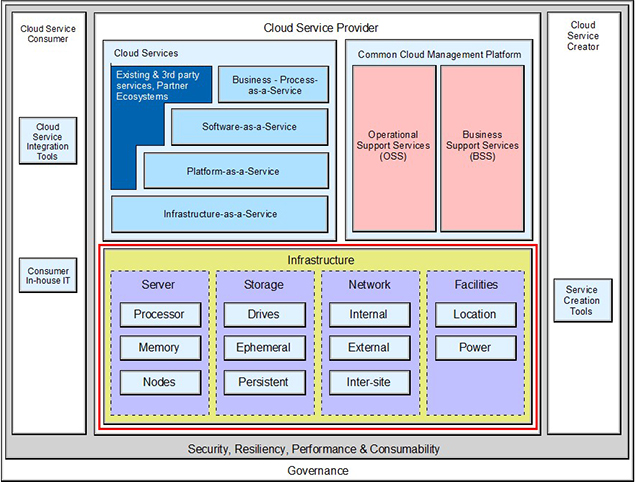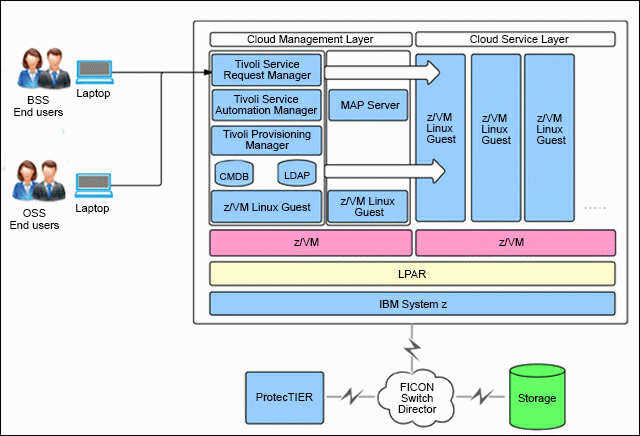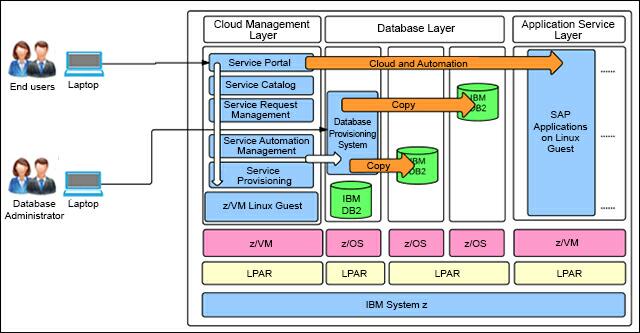Abstract
Cloud computing represents a shift to a more user-centered computing model where a layer of services sitting on an infrastructure decouples core business functions from the delivery of the underlying technology. IBM® recognizes that multiple ways exist to deliver IT capabilities, which include traditional software, hardware, and networking approaches, pre-integrated systems and appliances, and new breakthroughs that are provided as a service. This IBM Redbooks® Solution Guide offers more information.
Contents
Cloud computing represents a shift to a more user-centered computing model where a layer of services sitting on an infrastructure decouples core business functions from the delivery of the underlying technology. IBM® recognizes that multiple ways exist to deliver IT capabilities, which include traditional software, hardware, and networking approaches, pre-integrated systems and appliances, and new breakthroughs that are provided as a service. This IBM Redbooks® Solution Guide offers more information. The IBM z13™ is based on a heterogeneous infrastructure, with end-to-end management capabilities for flexible delivery of high value services. Because of this, it is ideal for meeting the requirements of the IBM Cloud Computing Reference Architecture (CCRA). IBM CCRA (Figure 1) defines fundamental architectural elements which constitute a cloud computing environment. The requirement is for all these infrastructure components to be managed from a single, central Common Cloud Management Platform and be able to place instances of each cloud service on the corresponding infrastructure.

Figure 1 IBM Cloud Computing Reference Architecture infrastructure
Did you know?
The transformation to cloud computing quickened the adaptation of its key enabling technologies, such as virtualization. For clients looking to lower costs, perhaps by deferring capital expenditures or off-loading non-core IT processes, cloud computing presents a way to do so while still providing services and deploying them quickly. Cloud computing is becoming more widely used as technologies, such as virtualization, automation, and provisioning, mature. Because IBM z13, with its “shared everything infrastructure,” offers a fully virtualized system, integrating a cloud computing deployment as part of the existing IT optimization strategy and roadmap becomes easier.
The key benefits that are provided through cloud computing are virtualization, standardization and automation.
Virtualization
Standardization
Automation
Business value
Cloud computing on IBM z13 builds on the industry’s leading virtualization technology that uses virtualization, standardization, and automation to free the operational budget for new investments. This technology also allows you to optimize new investments for direct business benefits. The IBM z13 provides the following features:
IBM z13, as the IT industry’s first multi-architecture cloud solution, provides these benefits:
Solution overview
As an example of this cloud solution, we use a telecom provider that selected the IBM z Systems platform for the provider's Linux operating system consolidation and virtualization. That company wants to build a cloud platform but also wants to reduce its cost of operation and overall data center footprint. The company's strategy is to improve provisioning time for its business support system (BSS) and operational support system (OSS) to satisfy server requests of its users.
Solution architecture
Figure 2 is an architectural overview for a cloud solution using Linux on z Systems.

Figure 2 Overview of cloud solution on Linux for z Systems
In this example, the technology described in the following lists can be used.
Consolidated hardware, operating system, and software infrastructure
Cloud (IBM SmartCloud®)
Build monitoring and system management
IBM Wave for z/VM: IBM Wave is a new virtualization management product for z/VM and Linux virtual servers that uses visualization to dramatically automate and simplify administrative and management tasks:
Usage scenarios
This scenario is for the energy and utilities industry : SAP Cloud and Automation solution on z Systems. In this scenario, the fictional energy and utilities company, Fictional Energy E1, chooses the z Systems platform with its SAP application running on Linux for z Systems and database on IBM z/OS®. Energy E1 wants to reduce the time spent to copy and refresh complete SAP systems from days to hours with a cloud solution and SAP system automation, which can automate, standardize, and increase the speed of day-to-day operations for SAP systems, reducing the risk of mistakes caused by human error. The company wants to reduce time spent on complex, repetitive tasks, freeing up skilled staff for higher value work and deliver higher operational efficiency, helping to slash costs and accelerate the time-to-value ratio for new workloads.
Step 1: Build a virtual platform
Step 2: Build IBM Entry Cloud Solution for SAP with automated lifecycle management operations
Figure 3 illustrates the solution architecture overview.

Figure 3 Automate SAP System Copy with IBM Entry Cloud Solution for SAP
The IBM Entry Cloud Configuration solution automates complex tasks typically performed by administrators of databases, operating systems, storage systems, and SAP Basis. When combined with SAP NetWeaver LVM, the configuration can reduce the time spent to copy and refresh complete SAP systems from days to hours. The high degree of automation also improves the quality and efficiency of SAP operations. The Linux on z Systems, IBM Entry Cloud Configuration solution is the ideal productivity tool for any IT organization running SAP Business Suite on the IBM z13 with IBM DB2 for z/OS. It is well-suited for computer services organizations hosting SAP systems for their clients, and for any IT organization seeking to run its SAP operations with z Systems in an on-premises, self-managed, cloud computing environment. Figure 4 shows the added value of this solution and how the solution reduces operation and administration time when compared to traditional operations.

Figure 4 Value delivered by cloud, based on IBM internal use; might vary depending on underlying infrastructure
Integration
The solution integrates well with technologies and transactional and information services by using the following products:
Ordering information
Contact your IBM representative for IBM z13 ordering information.
Related information
For more information, see the following documents:

Figure 1 IBM Cloud Computing Reference Architecture infrastructure
Did you know?
The transformation to cloud computing quickened the adaptation of its key enabling technologies, such as virtualization. For clients looking to lower costs, perhaps by deferring capital expenditures or off-loading non-core IT processes, cloud computing presents a way to do so while still providing services and deploying them quickly. Cloud computing is becoming more widely used as technologies, such as virtualization, automation, and provisioning, mature. Because IBM z13, with its “shared everything infrastructure,” offers a fully virtualized system, integrating a cloud computing deployment as part of the existing IT optimization strategy and roadmap becomes easier.
The key benefits that are provided through cloud computing are virtualization, standardization and automation.
Virtualization
- Higher utilization
- Economy-of-scale benefits
- Lower capital expense
- Lower operating expense
Standardization
- Easier access
- Flexible pricing
- Reuse and sharing
- Easier integration
Automation
- Faster cycle times
- Lower support costs
- Optimized utilization
- Improved compliance
- Optimized security
- Better user experience
Business value
Cloud computing on IBM z13 builds on the industry’s leading virtualization technology that uses virtualization, standardization, and automation to free the operational budget for new investments. This technology also allows you to optimize new investments for direct business benefits. The IBM z13 provides the following features:
- A highly scalable heterogeneous pool of virtualized resources that are managed in a single system
- On-demand activation, allocation, prioritization, and retiring of resources, and automation of service delivery
- Maximized utilization of resources for improved return on investment (ROI) and lower cost of service delivery
- Increased levels of security, resiliency, and manageability to create a cloud environment that is enterprise-ready
- More processing capacity, multithreading, and larger memory to consolidate different applications with less physical infrastructure
IBM z13, as the IT industry’s first multi-architecture cloud solution, provides these benefits:
- Higher utilization:
- Increased productivity:
- More efficient data center:
- Greater reliability and availability:
- Security:
– Up to 100% CPU utilization
– Shared everything architecture
– Hosting of thousands of mixed workloads
– Multithreading capability
– Single point of control for a heterogeneous infrastructure at a platform level, with Unified Resource Manager
– Efficient, rapid provisioning
– Superior workload management that is enabled with Unified Resource Manager
– Workload optimization with fit-for-purpose approach
– Collocating applications where industry-leading IBM z/OS® transaction and data services run
– Less power and cooling
– Less floor space
– Fewer parts to manage
– Built-in hardware redundancy
– Decades of reliability, availability, and serviceability (RAS) innovation
– Capacity and backup on demand
– Decades-proven virtualization security protecting sensitive data and critical business processes in the cloud
– Resiliency management and fewer points of failure
– Extending IBM z Systems™ security to a private network across heterogeneous resources
Solution overview
As an example of this cloud solution, we use a telecom provider that selected the IBM z Systems platform for the provider's Linux operating system consolidation and virtualization. That company wants to build a cloud platform but also wants to reduce its cost of operation and overall data center footprint. The company's strategy is to improve provisioning time for its business support system (BSS) and operational support system (OSS) to satisfy server requests of its users.
Solution architecture
Figure 2 is an architectural overview for a cloud solution using Linux on z Systems.

Figure 2 Overview of cloud solution on Linux for z Systems
In this example, the technology described in the following lists can be used.
Consolidated hardware, operating system, and software infrastructure
- IBM z13
- IBM z/VM® 6.3
- Red Hat Enterprise Linux or SUSE Linux Enterprise Servers on the IBM z System platform
- IBM protecTIER Gateway TS7680 - Deduplication and Virtual Tape Library
Cloud (IBM SmartCloud®)
- Automation with cloud: IBM Tivoli® System Automation
- Automated provisioning: Tivoli Provisioning Manager
- Service Lifecycle Management: IBM SmartCloud Control Desk
Build monitoring and system management
- IBM Tivoli OMEGAMON® on z/VM and Linux: Information about your Linux instances running as z/VM guests and the Linux workloads reveal how they are performing and impacting z/VM and each other:
- Compare Linux operations side by side with detailed performance metrics.
- Data collection from the Performance Toolkit for VM (PTK is a prerequisite) complements data collection by the IBM Tivoli Monitoring for Linux for z Systems agent.
- With new Dynamic Workspace Linking, you can easily navigate between Tivoli Enterprise Portal workspaces.
- View and monitor workloads for virtual machines, groups, response times and LPAR reporting, and view reports about z/VM and Linux usage of resources such as CPU utilization, storage, mini-disk,s and TCP/IP.
- High-level views help executives understand how systems performance influences business and the bottom line.
- With granular views, IT staffs can more easily track complex problems that span multiple systems and platforms and share related information.
- Automate, simplify management and monitor virtual servers and resources, all from a single dashboard.
- Perform complex virtualization tasks in a fraction of the time compared to manual execution.
- Provision virtual resources (Servers, Network, Storage) to accelerate the transformation to cloud infrastructure.
- Use advanced z/VM management capabilities such as Live Guest Relocation with a few clicks.
- Delegate responsibility and provide more self service capabilities to the appropriate teams.
Usage scenarios
This scenario is for the energy and utilities industry : SAP Cloud and Automation solution on z Systems. In this scenario, the fictional energy and utilities company, Fictional Energy E1, chooses the z Systems platform with its SAP application running on Linux for z Systems and database on IBM z/OS®. Energy E1 wants to reduce the time spent to copy and refresh complete SAP systems from days to hours with a cloud solution and SAP system automation, which can automate, standardize, and increase the speed of day-to-day operations for SAP systems, reducing the risk of mistakes caused by human error. The company wants to reduce time spent on complex, repetitive tasks, freeing up skilled staff for higher value work and deliver higher operational efficiency, helping to slash costs and accelerate the time-to-value ratio for new workloads.
Step 1: Build a virtual platform
- IBM z13
- IBM z/VM 6.3
- Red Hat Enterprise Linux or SUSE Linux Enterprise Server on z Systems platform
- IBM DB2® for z/OS®
- IBM Database Provisioning System (DPS)
- Web application JCL Engine
- Database Management
- Integrated with DB2 Cloning Tool
- IBM DB2 Cloning Tool for z/OS: The DB2 Cloning Tool automates the cloning process to provide usable DB2 clones within minutes, boosting efficiency and freeing up DBA time.
- Quickly clones DB2 subsystems, DB2 table spaces, or index spaces to create up-to-date test environments.
- Automates the cloning process to provide usable DB2 clones within minutes.
- Clones a DB2 subsystem by renaming and cataloging the data sets, fixing the volume internals, and updating the DB2 internal control information.
- Fast copy technology quickly copies DB2 data sets within a subsystem or to a different subsystem.
- Automates the cloning process using any volume level technology (such as IBM FlashCopy®) to clone DB2 subsystems and any data set copy technology (such as FlashCopy) to clone table and index spaces, and automatically translates object IDs to simplify and automate refresh of data.
- SAP NetWeaver Landscape Virtualization Management (LVM): By streamlining and automating critical business processes, SAP NetWeaver LVM software enables your IT department to focus on responding to new initiatives, controlling IT costs, and differentiating your business.
- Manage your SAP landscape in physical and virtualized environments.
- Central management point for your SAP landscape, start/stop, and mass operations.
- Automate standard, day-to-day administrative and lifecycle management tasks.
- Save time, effort, and money by automating copy, clone and refresh.
Step 2: Build IBM Entry Cloud Solution for SAP with automated lifecycle management operations
- SAP System Clone: Provision a fresh SAP system based on a new system copy.
- SAP System Copy: Create a customized SAP system based on existing system.
- SAP System Refresh: Copy DB content from PRD to Non-PRD including post processing.
- Create an extra Dialog instance: Add extra application server instances, for example for monthly closing.
Figure 3 illustrates the solution architecture overview.

Figure 3 Automate SAP System Copy with IBM Entry Cloud Solution for SAP
The IBM Entry Cloud Configuration solution automates complex tasks typically performed by administrators of databases, operating systems, storage systems, and SAP Basis. When combined with SAP NetWeaver LVM, the configuration can reduce the time spent to copy and refresh complete SAP systems from days to hours. The high degree of automation also improves the quality and efficiency of SAP operations. The Linux on z Systems, IBM Entry Cloud Configuration solution is the ideal productivity tool for any IT organization running SAP Business Suite on the IBM z13 with IBM DB2 for z/OS. It is well-suited for computer services organizations hosting SAP systems for their clients, and for any IT organization seeking to run its SAP operations with z Systems in an on-premises, self-managed, cloud computing environment. Figure 4 shows the added value of this solution and how the solution reduces operation and administration time when compared to traditional operations.

Figure 4 Value delivered by cloud, based on IBM internal use; might vary depending on underlying infrastructure
Integration
The solution integrates well with technologies and transactional and information services by using the following products:
- IBM z13
- Red Hat Enterprise Linux on z Systems
- SUSE Linux Enterprise Server on z Systems
- SAP Automation
- IBM z/OS
- IBM HTTP server
- IBM WebSphere® Application Server
- IBM DB2
- IBM Wave for z/VM
- IBM SmartCloud
- IBM DataPower
- IBM MobileFirst Platform Foundation (formerly IBM Worklight®)
Ordering information
Contact your IBM representative for IBM z13 ordering information.
Related information
For more information, see the following documents:
- IBM z13 Technical Introduction, SG24-8250
http://www.redbooks.ibm.com/abstracts/sg248250.html - IBM z13 product page
http://www.ibm.com/systems/z/hardware/z13.html - IBM Offering Information page (announcement letters and sales manuals):
http://www.ibm.com/systems/z/announcement.html
Others who read this also read
Special Notices
The material included in this document is in DRAFT form and is provided 'as is' without warranty of any kind. IBM is not responsible for the accuracy or completeness of the material, and may update the document at any time. The final, published document may not include any, or all, of the material included herein. Client assumes all risks associated with Client's use of this document.
